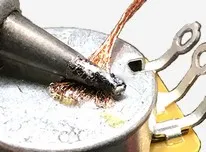In case the serial number of an electric guitar is absent or has become illegible, it is possible to date your guitar by checking the potentiometers. These components feature a code that indicates the manufacturer as well as the year and week of production, which is referred to as the EIA code.
Table of Contents
How to Find Potentiometer Codes?
The EIA code, consisting of 6 or 7 digits, can be observed on the back or side of the potentiometer, either stamped or punched. The code includes the manufacturer code and the year/week code, with a possible space or dash in between.
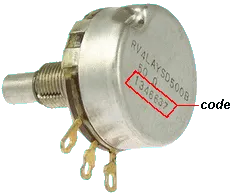
Often the EIA code cannot be read by the solder on the potentiometer. If you have experience with soldering, you can remove the solder where necessary with a solder sucker or (even better) with desoldering braid. If you have no experience or confidence, have someone do it for you.
How to Read Potentiometer Codes
The first 3 digits on a pot are the manufacturer code. The last 3 or 4 digits are the date code:
- With 3 digits, the first digit is the last digit of the year, and the last digit is the week number.
- With 4 digits, the first 2 digits are the last 2 digits of the year.
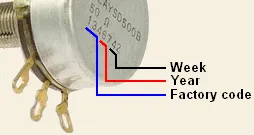
IRC (International Resistive Company) used a different date code system.
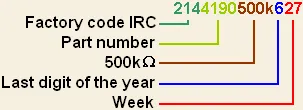
Example: 2144190500k627 is produced in July (week 27), 1956.
However, not all manufacturers have or use an EIA code on the potentiometers.
Guitar Dating By Potentiometer Codes
If the original potentiometers on a guitar are still intact and have not been replaced, it is possible to roughly determine the guitar’s production year using the EIA (Electronics Industry Association) code on the pots. This code provides information about the manufacturer and production date of the potentiometer.
However, it should be noted that this method only provides an approximation of the guitar’s production year since there is a period between the potentiometer’s production and its installation on the guitar.
This method is also useful for identifying the approximate production date of guitars from less well-known brands that do not have a serial number.
Based on the production date of the potentiometer, you can determine the approximate year of construction of the guitar. The potentiometers are of course produced earlier than the guitar, and in addition, there is always have supply in storage. Therefore, approximately 6 months must be added to the production date, but it remains an estimate.
Fender potentiometer dating
In the 50s, in the Fender guitars and amplifiers, mainly potentiometers of the Stackpole brand were used. Since 1963, the switch was made to the CTS brand.
To save costs, a huge stock of CTS was bought in 1966 that was installed on the guitars until 1971. Guitars made until 1971 can therefore have potentiometers with the datacode of 1966.
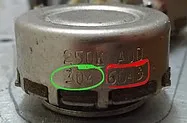
Gibson potentiometer dating
The suppliers of pots at Gibson are (were) IRC, CTS, CentraLab, and CGE (with the Gibson logo).
IRC and CGE were used in the 1950s. Due to the fragile construction of the CGE potentiometers (which show rapid wear over time), Gibson has therefore switched to pots from CTS and later on CentraLab.
Höfner potentiometer dating
Höfner guitars from before 1971 often do not have a serial number. You can read on the bottom of the pots of these guitars 128KΩ or 250KΩ with a 3-digit number. Here the first 2 digits are the week and the third digit is the year.
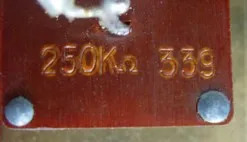
Often the EIA code cannot be read by the solder on the potentiometer. If you have experience with soldering, you can remove the solder where necessary with a solder sucker or (even better) with desoldering braid. If you have no experience or confidence, have someone do it for you.
When removing the solder, it is recommended to use a soldering iron with a wattage of approximately 40 and a temperature of around 700°F / 370°C if using a soldering station. The soldering tip should preferably be of the chisel type since it can transfer heat more effectively than a pointed tip. Press the braid onto the tin that needs to be removed with the soldering iron and wait for it to absorb the tin. After removing the solder, be sure to solder the connections back onto the potentiometer.
It might seem like something as simple as a potentiometer could affect the sound, but I once read an article about experiments with changing guitar pots. It felt more like a scientific study, haha! One day I’ll conduct my own experiment and definitely write a few lines about it – or maybe even a full paper! 🙂
